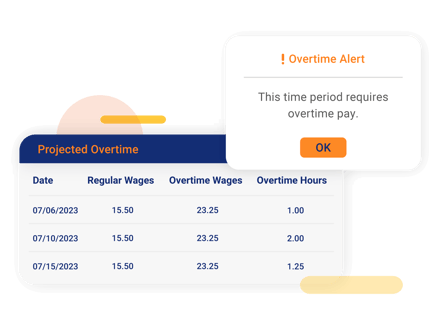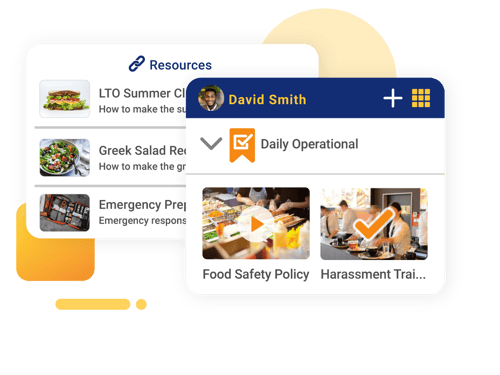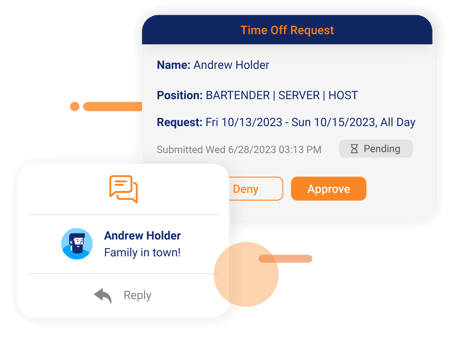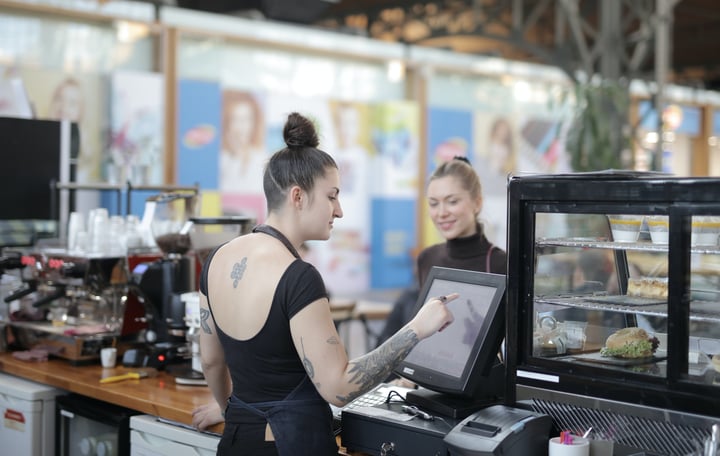
- Home
- Crunchtime Blog
- 4 Ways Restaurants Can Reduce Labor Costs Without Cutting Shifts

4 Ways Restaurants Can Reduce Labor Costs Without Cutting Shifts
Follow these strategies to help your restaurant save on labor costs, without compromising quality.
Staff shortages, high labor costs, and inflation are among the top challenges for restaurant operators today. While labor costs are necessary for providing excellent service and maintaining the quality of your establishment, restaurants can leverage different strategies to control these costs, without sacrificing staff or service quality.
Follow these strategies to help lower your restaurant's labor costs, without cutting shifts:
1. Train your managers to avoid overtime
Paying premiums for overtime can add up quickly. Your store managers should aim to avoid overtime whenever possible, but given staff shortages, this is often easier said than done. In some situations, it could be worthwhile to pay a premium if it will prevent the guest experience from being degraded.
Other times, overtime is accrued unintentionally. To avoid surprise overtime pay, set clear expectations and goals with your store managers and use relevant historical data to create attainable labor goals for each store. Equip your store managers with the following tools to help them limit the frequency of overtime pay:
- Tool #1: Scheduling guard rails – A restaurant scheduling software that incorporates labor rules is the best way to avoid accidental overtime when creating employee schedules. The platform should automatically trigger an alert during schedule creation if a proposed shift is going to incur overtime. You can easily make any necessary edits before publishing the schedule. These guard rails take the guesswork out of compliance and make it easy for your managers to create schedules that limit unnecessary overtime and other costly premium payments.
- Tool #2: Real-time alerts on the store floor – If a manager is constantly in the back office checking the schedule, they are less engaged with the team and guests. Equip your managers with restaurant management software that can provide real-time alerts and reports on the store floor, so they can proactively manage labor and make informed decisions throughout the shift. Alerts on a mobile app can provide quick scheduling reminders, like when a line cook is going into overtime so they can take action to control labor costs while remaining engaged.

2. Start tracking how often shifts are over-or-under-scheduled
Creating staff schedules is an ongoing challenge for many restaurants today. Managers must strike a careful balance to make sure shifts are staffed sufficiently to meet demand, while always keeping labor costs in check.
Restaurant operators recently reported an alarming 38% of shifts are insufficiently staffed in a given week. This includes shifts being under-or-over scheduled — both of which negatively impact restaurant operations. While under-scheduling may temporarily cushion your bottom line, it can quickly degrade the guest experience and impact quality.
On the other hand, over-staffing shifts can be a sneaky profit leak that directly leads to excess labor costs. Given the tight margins of the restaurant industry, there is little room for error when it comes to creating employee schedules, yet above-store management is often unaware that their overspend on payroll is eroding profits.
When evaluating the best restaurant scheduling app for your needs, focus on restaurant management software with the following scheduling capabilities, designed to lower labor costs:
- Operators need accurate, customizable forecasting – In order to create optimized schedules that accurately match demand, restaurants should prioritize an accurate forecast. If copying and pasting last week’s schedule is your go-to scheduling method, you are likely missing major opportunities to customize the schedule to match demand.
An accurate forecast should take different circumstances into consideration, like holidays or events that can greatly impact sales. The ability to customize the forecast is also key for busy restaurant operators today. For example, a restaurant should be able to adjust the forecast to show how many people to staff in positions for the drive-thru or the counter throughout the day to meet demand. - Operators need to automate scheduling tasks – By leveraging task automation, managers can use less manual effort to create schedules that match demand. The following scheduling tasks can be automated with restaurant scheduling software:
- Employee schedule requests
- Managing staff availability
- Staffing level templates
- Schedule templates
- Auto-scheduling
Auto-scheduling is a must-have feature in your restaurant scheduling software to lower labor costs. Auto-scheduling takes all of the factors listed above into account, then creates an optimized schedule that limits the risk of over-or-under-staffing positions. Scheduling with pen and paper, or spreadsheets, is no longer an effective way to maximize your workforce.
When a manager must manually consider each of those factors to build a schedule, they can easily spend 4+ hours creating schedules each week, and there's a good chance that shifts will be over-or-understaffed. BOH restaurant tech can completely transform the scheduling process for restaurants to help them optimize labor and boost profitability.
Discover more strategies and tips for scheduling in our full resource library
3. Cross-train your team
Cross-training employees is an undeniable strategy for maximizing labor efficiency and operators agree. In the same study that surveyed restaurant operators, over 50% said cross-training was a top strategy for labor management. The brands with over 51 stores cited cross-training as even more important, with 70% of operators listing it as a top strategy.
When employees are cross-trained, they can work multiple positions, allowing your restaurant to adapt quickly to staffing needs when unexpected situations arise — whether someone calls out unexpectedly or you experience an unanticipated lunchtime rush.
Although we know cross-training is an effective strategy, it can be a complex undertaking. Many restaurants are already resource-constrained and struggling with issues like high employee turnover. To make cross-training a feasible initiative at your restaurant, start with these steps:- Identify opportunities for cross-training — Start by identifying roles and tasks within your restaurant that can be cross-trained. For example, front-of-house positions like servers and hosts can often be cross-trained to some extent.
- Create a training program with specialized resources — Choose a learning management system (LMS) that aligns with your restaurant's needs and budget. The platform should accelerate the training process so you can rapidly train new and existing employees. Look for a restaurant-focused platform with features like content creation, course management, reporting, and a user-friendly interface. In the event your employees have extra time during a shift, they can easily work on training modules that are available on-demand in the LMS.
- Conduct hands-on training — Pair the employee being cross-trained with an experienced team member in the target role. Allow them to shadow and learn by doing. Encourage questions and provide feedback throughout the training. Pairing hands-on training with specialized on-demand learning courses is an ideal way to help employees retain information and feel confident moving into new roles.

4. Make it easy for employees to swap shifts
Schedule flexibility is closely linked with employee satisfaction. Employees value their work-life balance and they want to feel control over their time. It is also common for workers in the foodservice industry to have multiple jobs, which makes flexibility even more important. If your scheduling policies are overly rigid, it may be contributing to high turnover rates, which directly impact labor expenses.
Unfortunately, 30% of restaurant operators say they are not confident in their ability to make changes to schedules. Overseeing schedule changes can be incredibly time-consuming for managers who are often already overloaded with a variety of other tasks, but if employees feel their schedules are too constrained, it could start to impact their satisfaction at work.
In order to keep your restaurant from becoming a revolving door, schedule flexibility should be a top priority.
Here are several ways you can improve the flexibility around your scheduling process:
- Tip #1: Utilize a restaurant scheduling app to handle changes and requests — Ensure schedule flexibility by using a restaurant scheduling app that allows employees to list their availability, swap shifts, and communicate with management. In just a few clicks, the manager can approve changes to the schedule and jump right back to work on their other responsibilities.
- Tip #2: Maintain open communication with your staff — Encourage your team to communicate their scheduling preferences and any changes in their availability. A mobile scheduling app should also provide a method for employees and managers to send messages to one another.
- Tip #3: Take your employees’ preferences into account — Always consider your employees' preferred schedules and days off when creating the schedule, as this can lead to greater job satisfaction and retention. While some jurisdictions require this as a part of Fair Workweek regulations, it is a helpful practice to incorporate regardless of where you operate. Your labor and scheduling platform should allow employees to request time off, list their availability, or update their availability for exactly this purpose.

It's important to note that while controlling labor costs is essential for restaurant operations, it should be balanced with the need to maintain a high standard of service. Reducing labor costs does not need to come at the expense of service quality or the well-being of staff, as these factors also play a significant role in the success of a restaurant.
Instead, restaurants should view labor cost control as a comprehensive strategy that seeks to improve various aspects of the operation. Using restaurant management software, restaurants can focus on limiting unnecessary overtime, creating optimal schedules, cross-training, and schedule flexibility — all of which can impact on labor costs.
Ready to improve your scheduling and lower costs?
Restaurant scheduling software can make labor cost savings an attainable goal for brands of all sizes. If you are interested in lowering your restaurants’ labor costs, get in touch with us.
Share this post
Related


The Restaurant Operator’s Guide to Fair Workweek



